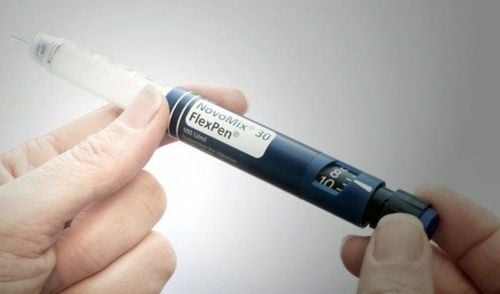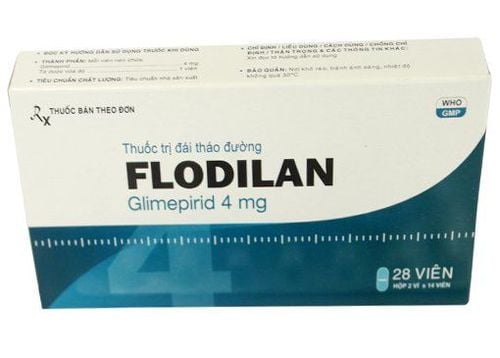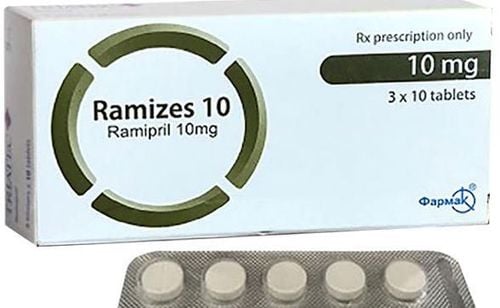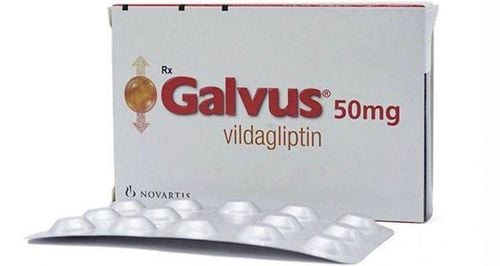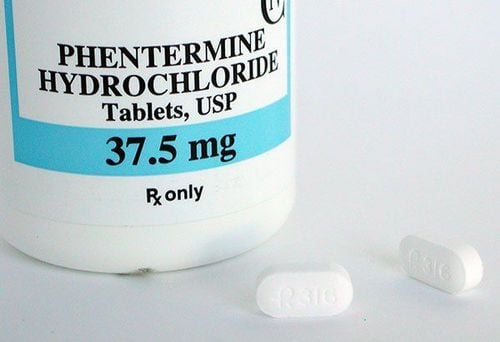This is an automatically translated article.
NovoRapid is a rapid-acting insulin used in the treatment of diabetes in adults and children 2 years of age and older. Dosage of NovoRapid is adjusted according to the condition and needs of the individual patient. The following article provides you with information about the uses, uses and possible side effects of using NovoRapid.
1. Uses of NovoRapid
NovoRapid drug has the main ingredient is Insulin aspart. Insulin aspart, produced by recombinant DNA technology in Saccharmyces cerevisiae cells, is used for glycemic control in both adults and children with diabetes.
NovoRapid is available as a clear, colorless solution for injection in a pre-filled syringe. Each 1ml of NovoRapid solution contains 100IU of Insulin aspart (equivalent to 3.5mg). Each pre-filled syringe contains 3ml or 300IU. The drug is packaged in a box of 5 pre-filled syringes x 3 ml.
With lower glucose concentrations, NovoRapid has a faster onset of action than human soluble insulin. NovoRapid usually takes effect within the first 4 hours after a meal.
After subcutaneous administration, NovoRapid has a shorter duration of action than human soluble insulin. NovoRapid has an onset of action within 10 - 20 minutes after subcutaneous injection and reaches its maximum effect about 1-3 hours after injection, duration of action is about 3-5 hours.
2. Indications and contraindications of NovoRapid
2.1.Indications NovoRapid is indicated for the treatment of diabetes mellitus and its complications in adults, adolescents and children 2 years of age and older.
2.2.Contraindications NovoRapid 100IU/ml is contraindicated in patients who are allergic or hypersensitive to Insulin aspart or any component of NovoRapid.
3. How to take NovoRapid
NovoRapid is used by subcutaneous injection, continuous subcutaneous infusion (CSII). In addition, the drug can be injected directly into the vein, but must be administered by medical personnel. NovoRapid should not be administered intramuscularly.
Care should be taken to change the injection site each time, in the same injection area to reduce the risk of lipodystrophy. The most common injection sites for insulin aspart are the abdominal wall, the upper arms, the buttocks, and the front of the thighs. Insulin aspart will act more quickly if injected into the abdominal wall in the same way as other insulins.
While taking NovoRapid, you need to check your glucose regularly.
Before using NovoRapid, you need to carefully read the instructions for use and the included NovoRapid® FlexPen® injection pen. Consult your doctor if you have any questions to ensure the safest and most effective use of your medication.
3.1. NovoRapid Dosage NovoRapid is a rapid-acting insulin analogue. Dosage of the drug varies depending on the individual and the needs of the patient. Insulin aspart is often used in combination with intermediate or long-acting insulin, which is given at least once a day. To achieve optimal glycemic control, blood glucose should be monitored and insulin levels adjusted to obtain the most appropriate dose for the patient. The dose of insulin in adults and children is usually 0.5-1 IU/kg/day. In the background-bolus regimen, 50-70% of this dose is provided by NovoRapid and the remainder by intermediate or long-acting insulin. Patients who increase physical activity, change their diet or are suffering from other diseases need to adjust the amount of insulin in accordance with the needs of the patient. NovoRapid has a faster onset of action than human soluble insulin, so NovoRapid is usually taken just before a meal. In some necessary cases, NovoRapid can be used immediately after meals. NovoRapid is less likely to cause nocturnal hypoglycemia due to its short duration of action. The dosage of NovoRapid above is for reference only. For a safe and appropriate dose of medication, you should consult with your doctor or healthcare professional. 3.2. NovoRapid Overdose and Management The main consequence of NovoRapid overdose is hypoglycemia with symptoms such as feeling of hunger, body sweating, headache, tremor, myasthenia, visual disturbances, irritability, confusion. confusion and coma. Some predisposing factors for the occurrence of hypoglycemia are alcohol use, hunger, excessive physical activity, use of the wrong dose, intramuscular injection...
Mild hypoglycemia (sweating, palpitations , tremors, headaches, paleness) can be treated with oral glucose or sugary products. Therefore, diabetics are advised to carry sugar-containing products with them at all times.
Severe hypoglycaemia (coma, convulsions) when the patient is unconscious, can be treated with intramuscular or subcutaneous glucagon (0.5 to 1 mg) given by someone trained in the injection, or intravenous glucose infusion.
If the patient has no or no response to glucagon after 10-15 minutes, intravenous glucose infusion is required. Continue continuous intravenous glucose infusion to maintain satisfactory blood glucose levels until the patient is awake and able to eat. Monitor the patient closely to avoid the risk of hypoglycemia returning. When the patient regains consciousness, it is necessary to give food containing sugar to prevent the coma from returning.
4. Undesirable effects when using NovoRapid
The most common undesirable effect during drug use is hypoglycemia and hypokalemia may also be encountered. The frequency of hypoglycaemia varies with patient group, dose regimen, and degree of glycemic control. Particular attention should be paid to groups of patients at high risk such as poor response to hypoglycaemia or patients taking potassium-lowering drugs. Reduce the potential risk of late postprandial hypoglycemia from insulin aspart by altering meal times, frequency, and amount of food, or changing exercise regimens. Injection site reactions: Similar to other insulins, injection site reactions such as pain, urticaria, itching, redness, bruising or inflammation of the injection site may occur. Each injection requires a continuous change of injection site in the injection site, which can help reduce or prevent these reactions. Allergy or hypersensitivity reactions to insulin may occur: urticaria, anaphylaxis or angioedema.
5. Precautions while using NovoRapid
Hypoglycemia is the most common side effect when using insulin for patients. Therefore, insulin should be used with caution in any patient, particularly in patients with type 1 diabetes, autonomic neuropathy, or erratic eating, exercise, and no dose adjustment. insulin. Patients should be adequately counseled about the symptoms of hypoglycaemia and blood glucose should be checked regularly. Elderly patients, hepatic impairment, renal impairment: insulin dosage needs to be individualized. Therefore, it is necessary to be cautious and adjust the insulin aspart dose accordingly in the above subjects. Ability to drive and use machines: It is important to inform the driver or operator of machinery using insulin of the signs of hypoglycemia, thereby helping to avoid possible hypoglycaemia while driving. Driver. Pregnancy: NovoRapid can be used in pregnant women. Several studies have shown no adverse effects of insulin aspart in pregnancy and the fetus/newborn when compared with soluble human insulin. Lactation: There are currently no restrictions on the treatment of diabetes with NovoRapid in lactating women. Using insulin aspart in this population does not pose a risk to the child, however, the dose of NovoRapid should be adjusted accordingly.
6. Drug interactions
Drugs that may reduce the patient's insulin requirements: oral antidiabetic agents, beta-blockers, angiotensin-converting enzyme (ACE) inhibitors, monoamine oxidase inhibitors, salicylates, anabolic steroids and sulphonamides. Drugs that may increase the patient's insulin requirements: oral contraceptives, thiazides, glucocorticoids, growth hormone, thyroid hormone, sympathomimetic. Beta-blockers may mask symptoms of hypoglycemia. Octreotide/lanreotide may increase or decrease a patient's insulin requirements. Alcohol: increases or decreases the hypoglycemic effect of insulin.
7. Storage of NovoRapid
Store in the refrigerator (2 - 8°C). Keep away from the refrigeration unit and not in the freezer compartment. NovoRapid® must be protected from excessive heat and light. After first use or as a spare: Do not refrigerate. Store below 30°C. While using NovoRapid, the expiry date is within 4 weeks. Cover NovoRapid® Flexpen to protect from light. NovoRapid is a rapid-acting insulin used in the treatment of diabetes in adults and children 2 years of age and older. To ensure the effectiveness of treatment and avoid side effects, patients need to take the medicine exactly as directed by the doctor, professional pharmacist.
Follow Vinmec International General Hospital website to get more health, nutrition and beauty information to protect the health of yourself and your loved ones in your family.
Please dial HOTLINE for more information or register for an appointment HERE. Download MyVinmec app to make appointments faster and to manage your bookings easily.




